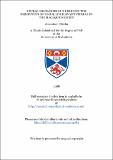Files in this item
Neural mechanisms underlying the perception of socially relevant stimuli in the macaque monkey
Item metadata
| dc.contributor.advisor | Perrett, David | |
| dc.contributor.author | Mistlin, Amanda J. | |
| dc.coverage.spatial | 318 p. | en_US |
| dc.date.accessioned | 2018-07-02T10:23:15Z | |
| dc.date.available | 2018-07-02T10:23:15Z | |
| dc.date.issued | 1988 | |
| dc.identifier.uri | https://hdl.handle.net/10023/14784 | |
| dc.description.abstract | Present knowledge indicates the importance of one region of monkey temporal association cortex, the superior temporal sulcus (STS), in predominantly high level analysis of 'biologically' important objects. To clarify and elaborate on the function of the monkey STS, the following questions are addressed: (1) what kind of tactile processing occurs in the polymodal STS and does it compare with the complex visual processing observed; (2) does behavioural sensitivity to face and body information parallel neural sensitivity (of STS cells) to the same stimulus dimensions; (3) does monkey STS ablation result in a behavioural indication of impairments in the perception of socially relevant stimuli; and (4) are visual cells in the STS sensitive to social communicational elements of facial or postural expression? Single-unit recording studies of the macaque STS (using standard techniques in awake, behaving animals) reveal a population of somatosensory neurones, with large receptive fields, sensitive only to unexpected (unpredictable) tactile stimulation. Complex tactual-visual interactions observed stress the importance of this dimension of processing. A separate population of visual cells exhibit sensitivity to compound facial expressions and head/body postures important in primate social communication. A behavioural study of monkeys' socio-emotional responses to configurational aspects of faces, the posture of the head and the interaction of form and motion, reveal their ability to discriminate salient cues in the context of social communication/interaction. It is tentatively shown that monkeys with the STS ablated are unable to make such discriminations, so reacting inappropriately to the stimuli (a symptom of Kluver-Bucy syndrome). The combined findings show that the STS performs a multimodal perceptual analysis of socially relevant stimuli, and suggest that the STS provides a sensory input to a limbic structure, such as the amygdala, through which it mediates appropriate emotional reactive behaviour. | en_US |
| dc.language.iso | en | en_US |
| dc.publisher | University of St Andrews | |
| dc.subject.lcc | QP363.M5 | |
| dc.subject.lcsh | Neurons | en |
| dc.title | Neural mechanisms underlying the perception of socially relevant stimuli in the macaque monkey | en_US |
| dc.type | Thesis | en_US |
| dc.type.qualificationlevel | Doctoral | en_US |
| dc.type.qualificationname | PhD Doctor of Philosophy | en_US |
| dc.publisher.institution | The University of St Andrews | en_US |
This item appears in the following Collection(s)
Items in the St Andrews Research Repository are protected by copyright, with all rights reserved, unless otherwise indicated.

